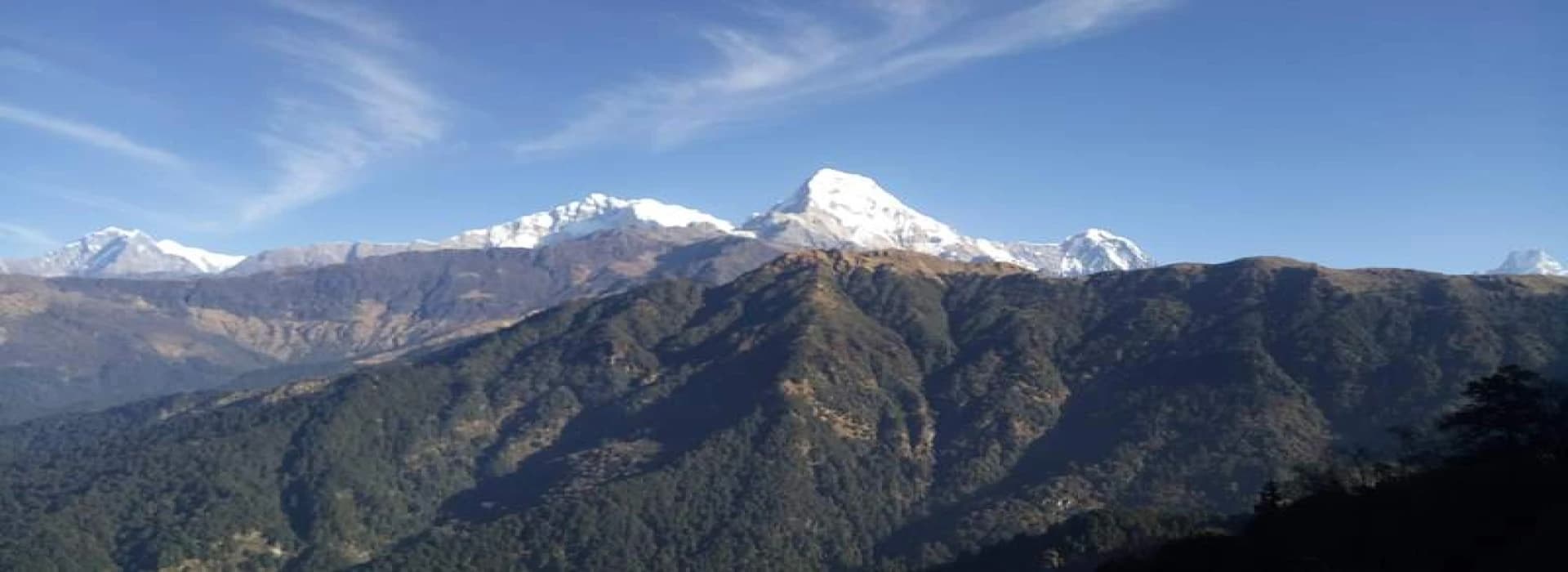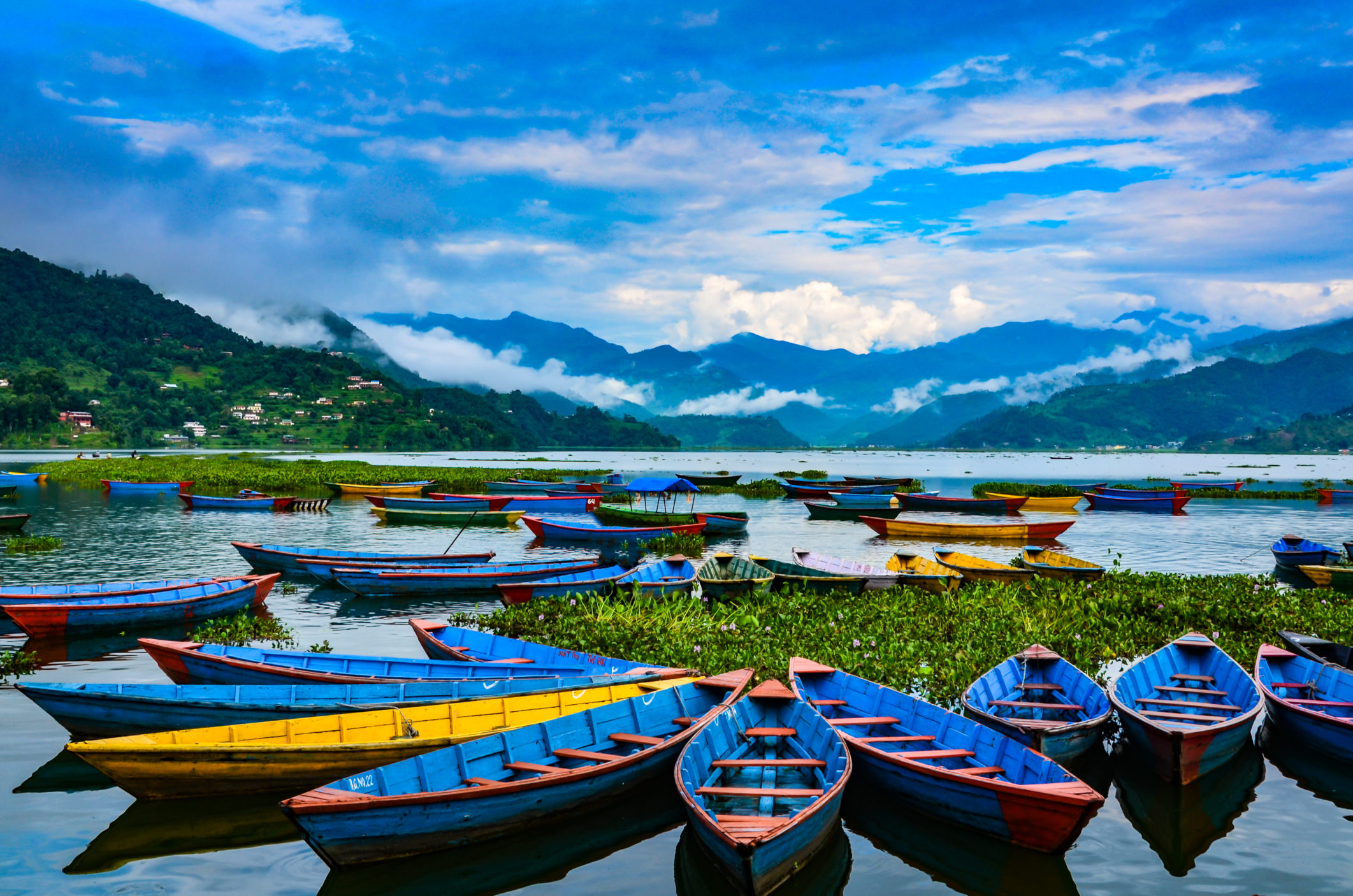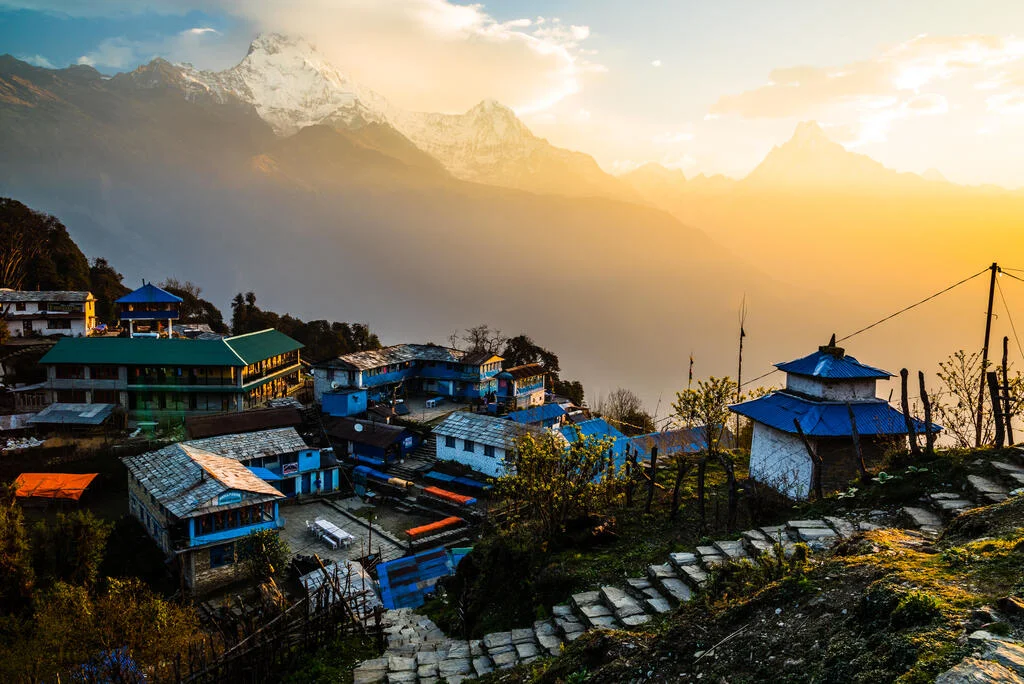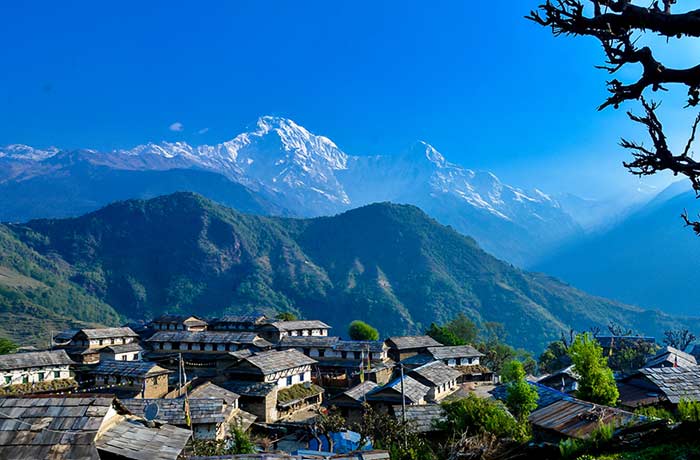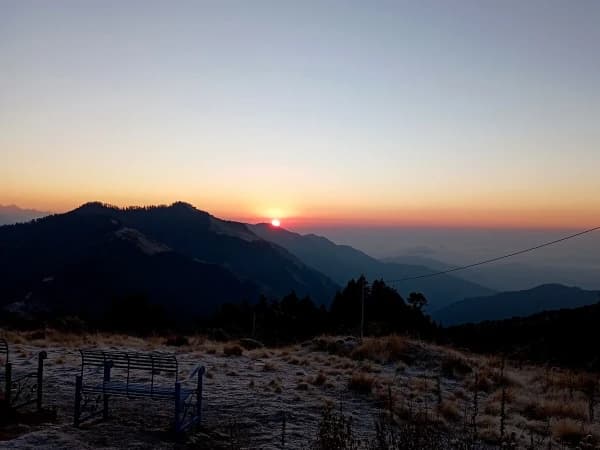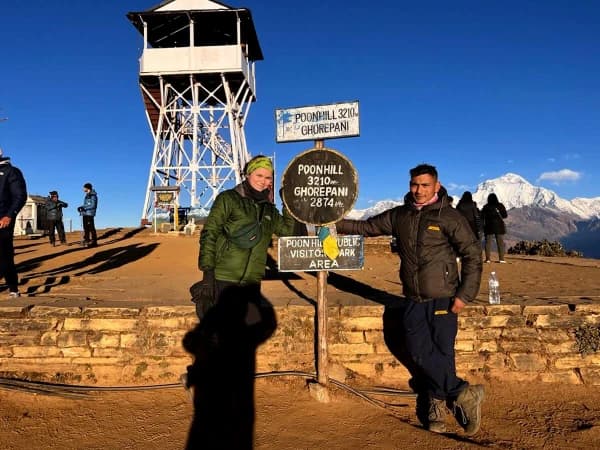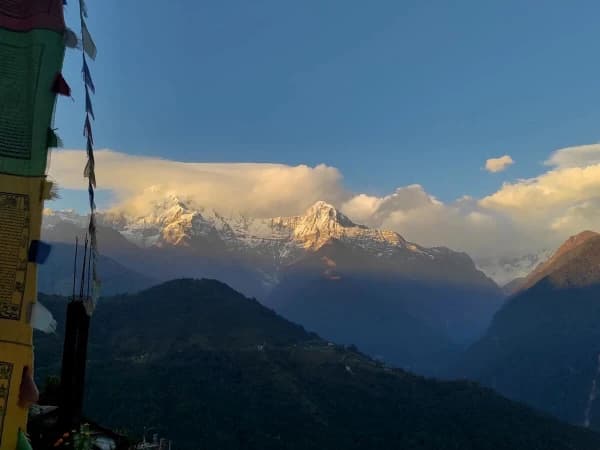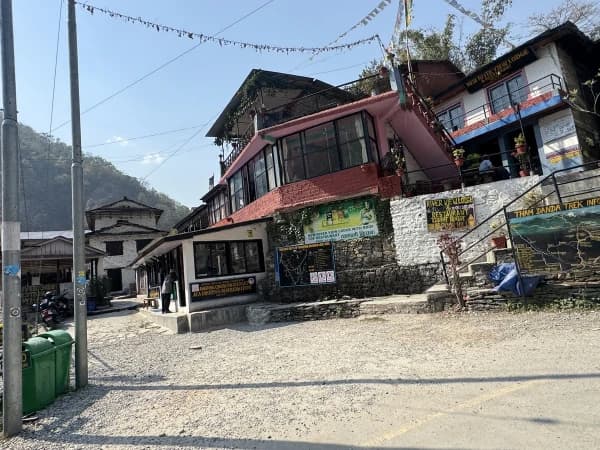My girlfriend and I have done the Langtang trekking under
The Ghorepani Poonhill Trek is the ultimate short trek that you can do, no matter what age you are, and no matter how experienced or inexperienced you are. This 4 or 5-day-long trek is generously rewarded with the best Mountain vistas from the ultimate viewing point, Poon Hill (3,210m). The viewpoint provides a unique perspective for viewing the Annapurna range (8,091 m), Dhaulagiri (8,167 m), Nilgiri (7,061 m), Tukuche (6,920 m), Varaha Shikhar (7,847 m), and Lamjung Himal (6,983 m).
Ghorepani Poonhill is located in the Annapurna Conservation Area (ACAP) of Gandaki province. This destination is popular for its panoramic sunrise view over the Himalayas from the viewpoint.
The journey commences with a scenic 3-4 hrs drive from Pokhara to Banthanti, and upon arrival, trek for 3- 4 hrs by uphill stone steps through rhododendron forest and small settlements along the trail to reach Ghorepani. The second day, you will go for an early morning hike for 1 hr, basically a round trip in the area.
After a 5 to 6-hour trek, we reach Tadapani (2,630m). On this day, you will mostly be walking steep sections on your hike to Poonhill, then going through forest trails and ridges.
From this viewpoint, you will enjoy panoramic views of various Himalayan giants. You might also encounter monkeys, birds, and rhododendrons in the forest trails. The peaceful trails go perfectly with the beautiful mountain backdrop and the warm hospitality of the locals.
On the third day, we will continue our trek through the downhill forest path to reach Ghandruk after 3 to 4 hours of trekking. There will be a local jeep or bus for our pickup to head back to Pokhara, which marks the end of our trek.
During your hike, you will explore Ghandruk, observe traditional Gurung villages with picturesque Mountain views, and stone-made houses.
Upon arrival, we will stay overnight in Pokhara to relieve all of our physical and mental exhaustion from the trek and reminisce about the beautiful journey we had. The fourth day is optional; you can rest in Pokhara and do recreational activities like boating in beautiful Fewa Lake, pay a visit to the World Peace Pagoda, or book both massages and spa services. You can explore the streets of Pokhara and enjoy your rest as well.
This is a trek with a perfect blend of natural beauty in the Himalayas and culture & traditions of the local people in the mountain region. You will come across several traditional Gurung and Magar villages, which will assist you throughout your journey with warm hospitality.
While the trek itself might be short and accessible but the rewards are incomparable and truly one of a kind. If you are physically fit and a novice traveler with limited leisure time, this is the ideal trek for you.
Highlights of the Ghorepani Poon Hill trek
- The wide Panorama of the majestic Annapurna range and surrounding Himalayas from Poon Hill viewpoint (3,210m) high without extreme altitudes.
- Witnessing the enchanting sunrise at Poon Hill, it is protected by a golden hue over the Himalayan peaks.
- A chance to observe three iconic mountains, which are over a thousand meters high, namely Dhaulagiri (8,167m), Manaslu (8,163m), and Annapurna I (8,091m).
- Witnessing picturesque waterfalls, rivers, rice terraced farms, lush oak forests, and rhododendron forests.
- Beautiful cultural villages along the way to Ghorepani Poonhill, such as Birethanti, Hille, Tikhedhunga, and Ulleri.
- You can effortlessly complete this Poon Hill trek in the Annapurna region within two nights and 3 days from Pokhara.
- You will also have the option of a two-way scenic flight to Pokhara from Kathmandu and back to Kathmandu in case you are short on time.
- Charming and cozy teahouses along the trekking route.
Why the Ghorepani Poonhill trip?
The Ghorepani Poonhill trek is the most popular and rewarding trek among various visitors from various backgrounds since the rewards from this trek are to die for, considering the very little altitude difference with no intense hiking and short duration. Trekking to Poonhill allows all people to enjoy the natural beauty of the Himalayan region and the beautiful & authentic culture of the Gurung and Magar villages.
Here are some of the reasons why you should choose Ghorepani as your next trek during your visit to Nepal:
- Beginner-friendly: This trek is suitable for people from various age groups and levels of experience who are looking to witness the beauty of Mother Nature and cultural immersion without any struggle for high-altitude trekking.
- Golden sunrise from viewpoint: Ghorepani Trek is famous for its beautiful golden sunrise view from Poonhill over some majestic peaks like Annapurna, Dhaulagiri, and Machhapuchhre (Fishtail).
- Low altitude trek: The trek takes you through minimal altitude changes ranging from 3,000m to 3,300m. So the hiking conditions are comfortable with low risk for altitude sickness.
- Rich cultural significance: This easy and short trek offers various opportunities for cultural exchange and interaction with the local people. Authentic Gurung and Magar villages can be seen throughout the trail, providing basic facilities to the visitors. Charming villages like Ghandruk offer visitors cultural immersion and unique experiences.
- Lush forests: This trek offers the opportunity to experience the beauty of the lush green forest of oak and rhododendron trees, just by traveling short distances and a comfortable trail. This is a perfect and quick getaway for visitors who want to spend time away from the hustle and bustle of the city.
How difficult is the Ghorepani Poonhill Trek?
Generally, trekking to Poon Hill is considered beginner-friendly, suitable for family trekking, and for anyone with basic fitness levels.
The max altitude throughout the trek is 3,210m, so there is little to no real risk of altitude sickness. Early morning hikes and uphill climbs might be difficult for a very few groups of people; other than that, it is a very light yet rewarding trek.
First Day- The first day is moderately challenging. It demands 3 to 4 hours of hiking to reach Ghorepani, passing through mostly uphill stone steps and trails of the forest. The ascent is gradual but continuous at the same time through rhododendron forests, so for those who are not used to uphill trekking, it might be a little hard.
Pro tip: Take frequent breaks and stay hydrated, since the altitude isn't too high, but it is a bit physically demanding.
Second Day- The second day might seem a bit more challenging than the first day. We go for an early morning hike to the viewpoint for 1 hour, and right after that, we trek to Tadapani for 5 to 6 hours. The early hike consists of steep uphill sections, which might seem a bit difficult. The undulating ridges and trails through the forest might also add to the difficulty, especially for novice trekkers.
Pro tip: If you are traveling in monsoon season, the trail can be muddy or slippery, so consider using trekking poles for more stability.
Third Day- The third day seems quite easier than the previous day since we will be losing some altitude, i.e., 2,630m → 1,940m (Ghandruk). The route mostly goes downhill with wide forest trails and steps, so your knees might deal with some stress, but doable.
Pro tip: Use trekking poles for more support and walk carefully on steep sections to avoid any accidents.
Fourth Day- This day is absolute fun, with no stress and difficulty at all, i.e., the rest day. On this day, the visitors do some light exercise, including stretching, massage services, and relaxation, as well as exploration at the lakeside, which marks the end of this journey.
How to train for the Poon Hill Trek?
Since this is a beginner-friendly and short trek, you do not have to go through any intense training or exercises. The regular exercise you do should be fine to keep you familiar, even with the demanding sections of the trek. Here are some of the things that you can do for a smooth and comfortable journey to Ghorepani Poonhill.
Cardiovascular Endurance:
- Regular walks- Be consistent with your daily walks, gradually increasing the distance and duration of the walk to build your stamina.
- Uphill and downhill practice hikes- Practice hiking uphill and downhill, recommended with a weighted backpack, to be familiar with the trek's terrain.
- Training on elevations- Try to train on trails with high elevation to prepare for the altitude changes during the trek.
Strength training:
- Leg exercises- Squats, lunges, and step-ups to strengthen your leg muscles.
- Core-enhancing exercises- Planks, sit-ups, and push-ups to strengthen your core for stability on rocky trails.
- Back exercises- Incorporate exercises that enhance your back muscles so that you can carry a backpack comfortably during your trek.
Balance and body flexibility:
- Yoga- Practice yoga and meditation in your routine for improved balance and body flexibility
- Stretching- Whole body stretching regularly to improve your muscle flexibility and prevent injuries during the trek.
Travel at your own pace: You don't have to keep up with anyone and just move forward according to your comfortable pace. The duration is short, so even if you take a long time and take slow steps, you will be able to reach the destination in time.
Light packing: Consider keeping your backpack light and only carrying items that are essential for a comfortable journey. Items like broken-in hiking boots, waterproof jackets, layers of clothing, a water bottle, etc.
When to trek Ghorepani Poonhill?
The best time to trek Ghorepani Poonhill is usually Autumn (Sep to Nov) and Spring (Mar to May). Good weather and perfect trekking conditions are assured in these seasons.
The views of the surrounding mountains, such as Annapurna and Dhaulagiri, are stunning; however, the trails will be crowded and limit the availability of services as well.
Here are more details to understand the temperatures better in different seasons:
| Seasons | Daytime Temperature | Night time Temperature |
| Spring | 18° c to 24° c | 2° c to 14° c |
| Autumn | 9° c to 22° c | 0° c to 12° c |
| Winter | 5° c to 15° c | -6° c to 7° c |
| Monsoon | 14° c to 26° c | 10° c to 20° c |
Peak season for the Ghorepani Poon Hill trek
During autumn and spring, the temperatures are mild and comfortable during the day and cooler evenings and nights. The surrounding is filled with vibrant, blooming rhododendron flowers, creating a colorful landscape across the hills. Besides the natural beauty, the crystal clear sky allows for uninterrupted, breathtaking views of the Himalayan peaks like Annapurna and Dhaulagiri.
The monsoon rain cleans the forest, making the landscapes appear greener and fresher. Expect the cost of teahouses, food, and other amenities to be higher than in the off-season.
Off-season for the Ghorepani Poon Hill trek
The least favorable season for this trek is during the monsoon (Jun to Aug) and winter (Dec to Feb). In winter, the temperature is freezing, sometimes even below the freezing point during winter.
Overall, it made the uncomfortable experience and trek more challenging. Some parts of the trail may be blocked by snow, which may cause a delay in the journey. But if you prefer to travel peacefully and with few challenges, then this is the time. The snow-capped mountain view and winter scenery have charm of their own.
Likewise, in summer or also known as monsoon in Nepal, the view is usually obstructed because of clouds, interrupting the views of the mountains. The weather is warm but wet at the same time because of frequent rain showers, increasing the difficulty of the trail with slippery and muddy conditions.

